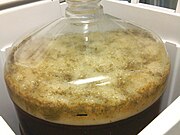Frizz
As Kräusen is called the in the stage of primary fermentation located wort . The term krausen describes the foam formation and the foam pattern on the fermenting wort, it looks like kinky hair. The carbonic acid produced during fermentation is responsible for the formation of foam . A distinction is made between different stages of frizz, beginning with the so-called over white (yeast begins to ferment and enters the stage of cell division ). In the next phase the foaming becomes a little stronger, this stage is known as young or low ruff. If more cells are present due to the multiplication of the yeast, the fermentation begins to become even stronger and is characterized by strong foam formation, the high frills. This is also the time when part of the fermenting wort can be removed in order to be able to curl up in the storage cellar. Raising is used for storage and maturation and supplies fresh fermented yeast cells that are able to carry out the secondary fermentation to the fermented young beer . In the high curl stage of the main fermentation, hops , malt residues and protein coagulated during the wort boiling are carried up by the fermentation carbonic acid into the foam cover, it becomes dirty brown over time and collapses more and more towards the end of fermentation. If gaps form in the foam blanket that has been closed up to now, one speaks of the breakthrough, the end of the main fermentation.
As Kräusenbier referred to finished fermented beer, to which a proportion of hochgärendem green beer for ripening in the storage tank, bottle or keg is added.
source
- Ivo Hlavácek u. a .: The development of production and technology in the Pilsner Urquell Brewery over the 125 years since its foundation ( 1842-1967 ) , in: Eduard Jalowetz: Pilsner Beer in the Light of Practice and Science , Vienna 1930, reprint Pilsen 1999, p 77
